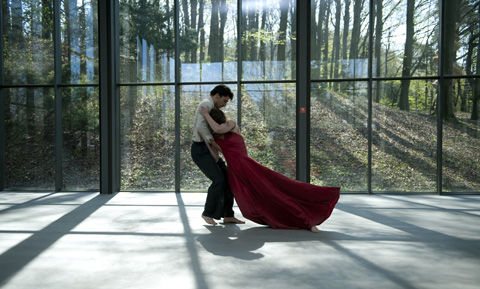
NEAT TRICK In some ways, Wenders gets deeper into Pina Bausch’s dance than a theater viewer could — including the sweaty clothes and bloody toe shoes. |
Wim Wenders's Pina (opening this Friday at the Boston Common) memorializes the late choreographer Pina Bausch with reverential tributes from her past and present dancers and excerpts from four of her works. Bausch's Wuppertal Dance Theater originated the neo-expressionist Tanztheater movement that overtook Europe's contemporary dance and infected much of the classical stage as well. Bausch distilled emotion and behavior into their most intense movement tropes, exposing the rough edges of the psyche. Her dancers performed with bone-deep sincerity, insisting that we respect their need for approval, even though it usually translated into bouts of sexual torment.
>> INTERVIEW: Wim Wenders on Pina by Peter Keough <<
Shot in breathtaking 3D, Pina treats dance with an expansiveness never seen before on screen. Bausch's work doesn't depend on the formal lineups and full-stage groupings that have defeated many previous attempts to capture choreography on film. Intent on scratching open the defenses of a dancer's personality, she relinquished most of the options of choreographic craft, including the pursuit of a specialized movement vocabulary. Even when her dances took place in proscenium spaces, their scenic designs revoked the theater's restrictions.
Wenders's camera roams around the territory, comes to rest on an interesting subject, zooms in on an activity, opens out, finds another point of energy. In some ways, he gets deeper into this dance than a theater viewer could. He can get close enough to savor the sweaty clothes and the brown mulch that sticks to the skin of the sexual warriors in The Rite of Spring (1975). He absorbs the claustrophobia of the imposing, solidly built box set that became a seedy dance hall or an empty restaurant (Kontakthof and Café Müller, both created in 1978). When Bausch succumbs to a relatively lighter mood and the dancers splash around in a stage waterfall (Full Moon, 2006), he makes us duck, to avoid getting wet.
Wenders scrutinizes the trembling self-consciousness and anxiety of adults, seniors, and teenagers at a singles dance (Kontakthof). He enables obsessive role-playing, in Café Müller, when an increasingly desperate parent-surrogate pushes two grown people together over and over again. The camera inspects the couple's dank passivity as they get clamped together, lose their grip and collapse, endure another forced embrace. It watches as a woman in Kontakthof stands absolutely still while 10 avid men surround her and touch her body in intimate ways.
Later, Wenders takes the same compulsions outdoors, where the people keep acting out, indifferent to their realistic settings. A woman glides around on bloody toe shoes in the yard of an industrial plant. A man has to walk with eyes closed and branches balanced on his arms, shoulders, and head. People perform alienated actions in moving trains, glass-enclosed tennis courts, galleries that look like ancient tombs. Their exertions simply stop or drift out of the frame without any resolution or effect.
Alternating with these powerful metaphors, the camera stops dead, fixed on one dancer after another, to create a facebook of portraits. The dancer stares pensively into the camera; a voiceover and if necessary an English subtitle conveys his or her memory of Pina as beloved teacher, director, parental figure. Finally an archival black-and-white clip shows Bausch herself, slipping through a dance in her customary white shift. Unlike her dancers, she's composed, ghostly, unscathed.